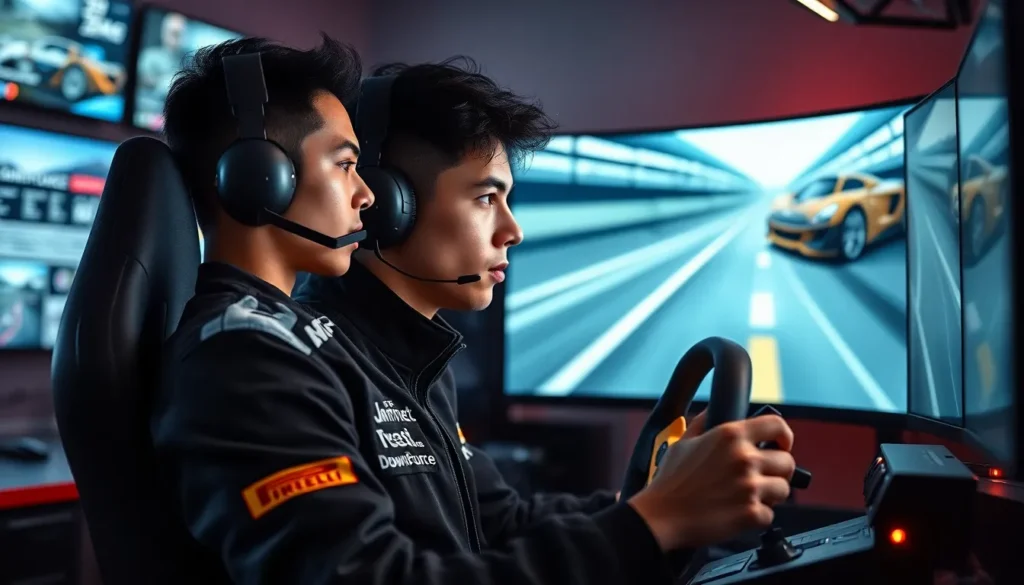Table of Contents
ToggleIn the high-speed world of racing games, mastering downforce settings in Forza can feel like trying to solve a Rubik’s Cube blindfolded. But fear not! Understanding how to tweak these settings can transform a car from a wobbly jelly on wheels to a precision-engineered speed machine. Whether you’re drifting around corners or blasting down straights, the right downforce can mean the difference between a podium finish and a spectacular crash.
Overview of Forza Downforce Settings
Downforce settings play a crucial role in a car’s stability and performance. Adjusting these settings influences how well a car grips the road, particularly in high-speed turns and straightaways. Players should consider both front and rear downforce separately, as these adjustments can lead to varying results based on vehicle attributes.
Higher downforce leads to increased grip at the expense of top speed. Cars with significant downforce control better during sharp turns, allowing for faster cornering. Lowering the downforce enhances a vehicle’s top speed, beneficial for longer straights, but can compromise cornering stability.
Different racing scenarios call for different downforce settings. In circuit races with many turns, a higher downforce value suits most cars. Conversely, in drag racing scenarios where speed prevails, a lower downforce configuration often provides an edge.
Players can experiment with downforce settings during practice sessions. Observing how these changes affect lap times aids in finding the perfect balance between speed and handling. Utilizing telemetry information can offer insights into how downforce adjustments impact various track sections.
Understanding the balance of downforce contributes significantly to achieving race success. Mastering these settings enables players to tailor their car’s performance to their driving style and the specific demands of each track. It ultimately leads to improved lap times and competitive advantages.
Importance of Downforce in Racing

Downforce plays a critical role in racing, affecting speed and handling. Mastering this aspect can lead to significant performance improvements.
Effects on Vehicle Performance
Downforce directly impacts a vehicle’s grip on the road. Increasing downforce enhances traction, allowing for quicker cornering and better acceleration out of turns. Optimal downforce settings allow cars to maintain higher speeds with stability, particularly on track layouts with sharp curves. A notable balance exists; while more downforce increases grip, it can also reduce top speed on straightaways. Players must carefully calibrate settings to align with their specific racing environment.
Influence on Handling and Stability
Handling improves with the right downforce adjustments. High downforce levels provide better stability, making it easier to navigate through challenging sections of a track. Cars feel more planted and responsive during high-speed maneuvers, allowing drivers to push their limits confidently. Conversely, lower downforce creates a lighter feel, suitable for tracks that emphasize speed over cornering. Adjusting front and rear configurations can provide distinct advantages; ideal handling maintains control while maximizing performance in various racing conditions.
Types of Downforce Settings
Understanding the types of downforce settings enhances racing performance. Two primary settings are front and rear downforce.
Front and Rear Downforce
Front downforce controls grip at the vehicle’s front. Increasing it improves handling through corners. Rear downforce influences stability during acceleration and braking. Adjusting these settings affects car dynamics differently; higher front downforce provides better steering control while higher rear downforce increases traction. Players should consider vehicle characteristics when making adjustments. It’s crucial to find a balance that suits their driving style.
Adjustable vs. Fixed Settings
Adjustable downforce settings allow for real-time changes during races. This flexibility helps drivers adapt to evolving track conditions. Fixed settings, on the other hand, provide a predetermined level of downforce. Players often prefer adjustable settings for their versatility. Through practice, they can fine-tune downforce values tailored to individual preferences and race conditions. Utilizing telemetry can aid in assessing the effectiveness of chosen downforce configurations.
How to Optimize Downforce Settings
Optimizing downforce settings in Forza involves careful adjustments that directly impact performance. Players start by assessing the track layout. Tight circuits with sharp corners require higher front and rear downforce, enhancing grip. Long straight sections benefit from lower settings, allowing for increased speed.
Adjusting front downforce influences how well a car turns. Greater front downforce improves cornering but may compromise top speed on straights. Balancing this requires players to experiment with various values during practice runs.
Rear downforce, on the other hand, stabilizes the vehicle during acceleration and braking. With adequate rear downforce, cars respond more predictably when entering and exiting turns. Players should look for a balance between front and rear to achieve optimal handling.
Telemetry data serves as a valuable resource in this process. It provides insights on how different configurations affect lap times. Players can use this data to refine their settings further, tailoring them to personal driving styles.
Adjustable downforce settings prove advantageous during races. Real-time changes allow players to adapt to varying conditions without losing speed. Fixed downforce setups limit flexibility, making adaptive strategies challenging.
Players should prioritize trial and error to find what works best for their vehicles. They may discover that small incremental adjustments lead to significant improvements in overall performance. Remaining mindful of both grip and speed ensures a well-rounded setup.
Common Mistakes in Downforce Adjustment
Players often overlook the significance of balancing front and rear downforce. Ignoring this balance can lead to compromised handling characteristics. Adjustments made without considering the vehicle’s attributes can negatively impact performance during high-speed maneuvers.
Underestimating the effects of higher downforce values on top speed represents another common error. While increased downforce enhances cornering grip, it can hinder straightaway speed. Hesitating to experiment with different settings is also a frequent mistake. Adjustments in practice sessions can provide crucial insights into a car’s behavioral dynamics.
Failing to utilize telemetry data stunts players’ understanding of how downforce impacts lap times. Without this data, players miss valuable insights that guide precise adjustments. Relying solely on instinct rather than empirical data is not advisable for optimal performance.
Additionally, adjusting downforce in isolation can lead to car stability issues. Changes in one area should account for overall vehicle dynamics, fostering a more cohesive tuning approach. Neglecting to tailor settings for specific track layouts represents another misstep. Each circuit’s characteristics demand distinct downforce settings for ideal performance.
Lastly, players sometimes misjudge the need for adjustable settings during races. Fixed downforce settings limit the ability to adapt to evolving track conditions. Embracing flexibility in adjustments can significantly enhance a vehicle’s competitiveness and responsiveness on the track.
Mastering downforce settings in Forza is essential for any serious racer. The right balance between front and rear downforce can make all the difference in a vehicle’s performance. Players who take the time to experiment and adjust their settings will find themselves better equipped to handle various track conditions.
Understanding the impact of these adjustments on handling and speed can lead to improved lap times and a competitive edge. Utilizing telemetry data and being mindful of the specific demands of each race will further enhance a player’s ability to fine-tune their car. Ultimately, embracing the nuances of downforce settings allows racers to maximize their potential on the track.







